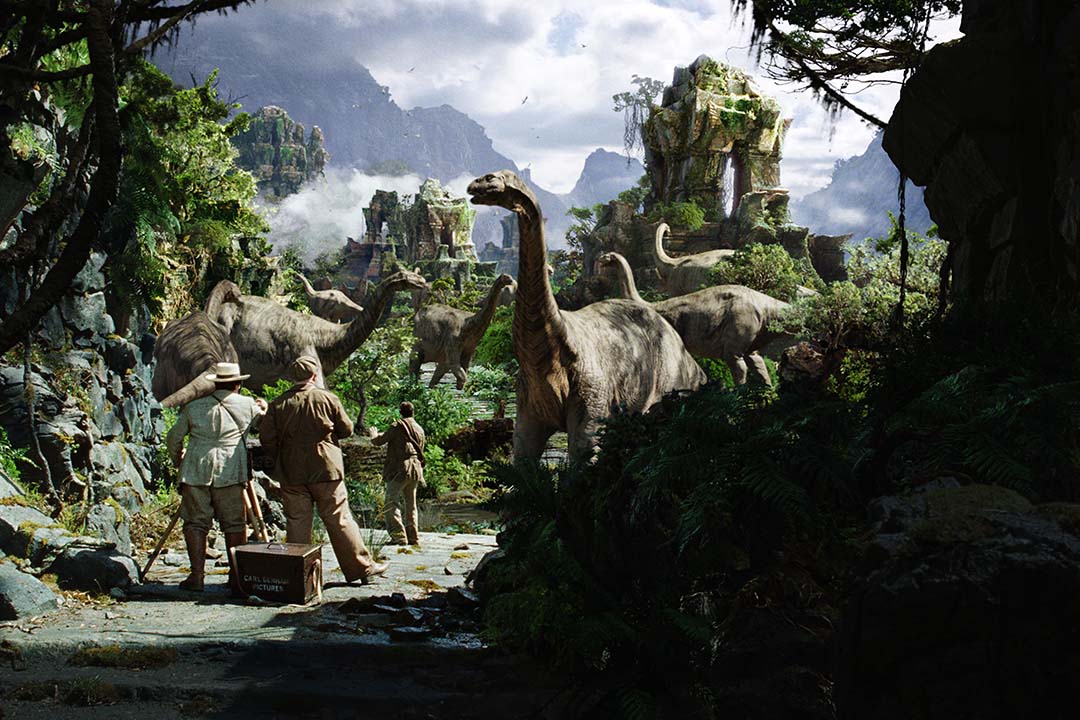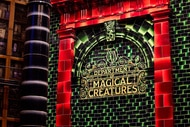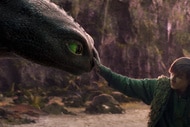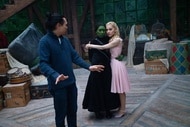Create a free profile to get unlimited access to exclusive videos, sweepstakes, and more!
All The Wild Things We Learned From the Tie-in Art Book Released for Peter Jackson's King Kong Remake
You'd think that Carl Denham would go to jail after unleashing a giant ape on Manhattan, but nope!

You'd think that Carl Denham would go to prison after unleashing a giant ape on Manhattan, but nope! The version of the unscrupulous filmmaker/businessman played to weaselly perfection by Jack Black in Peter Jackson's 2005 remake of King Kong (now streaming on Peacock) not only got off scot-free, but was also allowed to lead another expedition to Skull Island two years later in 1935.
This is 100% canon, by the way. And we know it's 100% canon thanks to one of the coolest movie tie-in books ever published. Taking the form of an academic text rather than your traditional making-of coffee table tome, The World of Kong: A Natural History of Skull Island takes an incredible deep dive into the creatures, biomes, and ecosystems found on the craggy landmass.
You see, after Kong took a nosedive off the Empire State Building, universities and private organizations from around the world tripped over themselves to reach the land forgotten by time in an effort to study and document the fascinating (and very hungry) fauna living there. Denham's second visit in '35 turned out to be a three-month expedition under the banner of Project Legacy, which launched a total of seven explorations to the island before it tragically sank beneath the waves around 1948.
All of that historical background was merely a clever pretext for the talented creatives at Wētā Workshop to show off the mounds of concept art and lore that never made it into the finished film.
The Story Behind The World of Kong: A Natural History of Skull Island
"There’s always a story behind the story to be told and when a film takes me to a world that I enjoy, I want to spend more time there and learn more," veteran Wētā designer and The World of Kong co-author Daniel Falconer tells SYFY WIRE over email. "There was a philosophy which Peter Jackson and [Wētā co-founder] Richard Taylor had instilled in us when we were working on The Lord of the Rings, which was to always imagine that the world extended beyond the confines of what appeared in the lens, and that if you could step through the screen and out of the camera, you could turn left or right and go exploring forever in that fictional universe."
It certainly helped that a number of team members "had academic backgrounds or experience in either biological or archaeological sciences" they could call on for the construction of a fictional land where evolution took a vastly different turn.
"It’s interesting how often interest in art and science overlaps; stories and imagery that inspire the imagination," adds Falconer, who, like co-author Ben Wooten, had studied biology in college. "We would geek out over dinosaurs and ancient ruins and other stuff like that. Someone might bring up an interesting fact about a certain extinct or living animal, and we’d start extrapolating how that could be incorporated into the fictional creatures we were designing or maybe lead to something cool onscreen. The conversations were exactly the kind of ‘wouldn’t it be cool if…?’ sessions that we had on the playground as 9-year-olds in school!"
The original plan was to take the expected route: present all of concept art with "the usual behind-the-scenes commentary." But much like the inhabitants of Skull Island, that idea began to grow until it bore almost no resemblance to its movie tie-in book forbears. "Our focus for The World of Kong was the make-believe tale of a mystery island full of monsters, and we had license to fill in the corners of the map not explored in the movie," Falconer says. "The truth is, we went a bit crazy!"
But sometimes, crazy is good. Falconer and his fellow creatives took to the project with gusto, singling out their favorite artwork, revisiting rejected pieces, and even concocting brand-new creatures. "The door swung wide open to re-examine almost everything we had previously generated for the film. Suddenly, rapidly-drawn film artwork was being revisited, revised, re-contextualized."
He continues: "Some carnivorous concepts we reworked into herbivores in order to craft a more believable biota, and putting on our best David Attenborough impressions, we began pulling from our development conversations to invent original biology for them all. To try to address the issue of an over-abundance of predators, we came up with the idea that the island was once significantly larger and that rapid loss of habitat had concentrated the wildlife into a very tight, competition-rich space, leading to lots of conflict."
The World of Kong divvies the island up into six distinct areas: Crumbling Coast and Village, Striking Lowlands, Winding Swamps and Waterways, Steaming Jungle, Abyssal Chasms, and Barren Uplands. All of them are populated by horrific abominations of nature: stampeding dinosaurs, man-eating bugs, giant bats, and water-dwelling leviathans perverted by unchecked evolution over untold eons of isolation and completely apathetic to the concerns of humankind. All of them beautifully rendered across 200 glorious pages cataloging each deadly denizen with illustrations, descriptions, and Latin designations (Jackson, of course, had final say on the scientific names).
"The picture formed could never be said to be a truly realistic depiction of island ecology," Falconer says. "It was definitely a monster mash inspired by and thinly-cloaked in some science; an encyclopedia of cool beasties. In truth, we spent wayyy more money and time indulging in speculative zoology than was probably justified, but we had so much fun."
Not that it's a contest or anything, but the massive bugs are clearly the coolest of the bunch, especially those foul, mud-dwelling worms (dubbed "Carnictis" or "Vile Meat Weasel" in the book) that eat Andy Serkis' character. That hair-raising scene where the last-remaining members of the rescue party battle an army of creepy-crawlies scuttling around the dark and dank ravines of Skull Island was a direct homage to the lost "Spider Pit" sequence cut from the 1933 original.
"Being famously arachnophobic himself, Peter Jackson’s own discomfort with multi-legged creatures was probably the force that drove that horror!" Falconer notes. "We all dug deep to try and come up with the most skin-crawl-inducing hideosities for that sequence."
With the 2005 book sadly no longer in print, copies of The World of Kong can be found on eBay for a whopping $200 (other listings have it more modestly priced around $150). Still, if you've got the extra cash to burn, it's a totally worthwhile investment, and besides, a pair of Benjamins are probably a drop in the bucket compared to what Falconer and the rest of the Wētā team ended up costing the studio.
"The final book took almost a year to create and completely blew its development budget, but we were very lucky to have understanding bosses who were as geeky and excited by the result as we all were who worked on it, so we got away with it," he concludes. "I doubt we’ll ever be so lucky again!"
Peter Jackson's King Kong is now streaming on Peacock.
Originally published May 26, 2023.



























